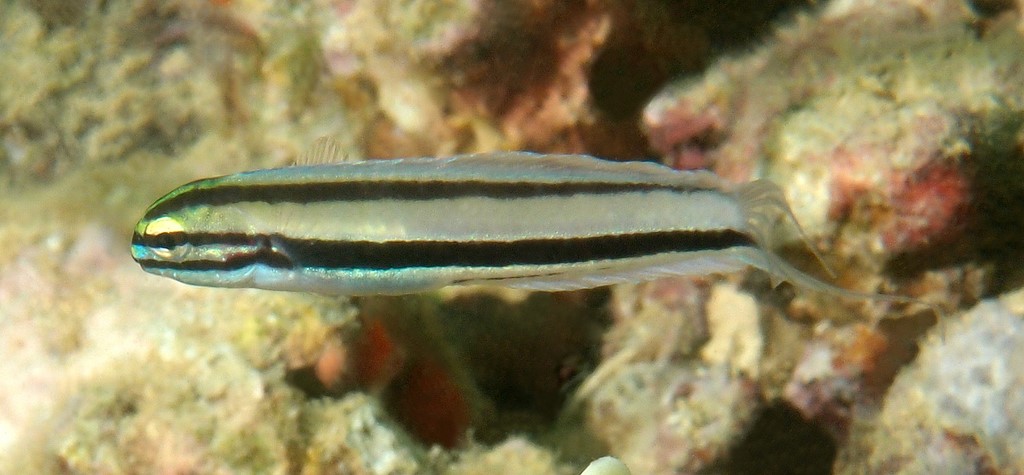MEIACANTHUS DITREMA - (SMITH-VANIZ, 1976)
Actinopterygii (Gigaclass) > Actinopteri (Class) > Teleostei (Subclass) > Blenniiformes (Order) > Blennioidei (Suborder) > Blenniidae (Family) > Blenniinae (Subfamily) > Meiacanthus (Genus)
Blennie à double pores, Schooling fangblenny, Schooling harp-tail, Doublepore fangblenny, One-striped poison-fang blenny, Satsukiginpo, Satsukigimpo, サツキギンポ, 叉紋稀棘鳚,
Description
Dorsal spines (total): 5-6; Dorsal soft rays (total): 23-25; Anal spines: 2; Anal soft rays: 15-18; Pectoral fin rays: 14. Males with long filaments from the tips of the tail. Max. length: 6.5 cm TL. Depth range: 0 - 18 m.
Color
Whitish body with two narrow black stripes along the body, the first along the base of the dorsal fin, the second divided on the head and joined into a single stripe at the pectoral fin base, and running along the midsides to the caudal fin base.
Etymology
Meiacanthus: from Greek, meion = less or lessen + from Greek, akantha = thorn. Referring to dorsal fin with only 4-8 spines, compared to 10-12 on the related Petroscirtes.
ditrema: from Latin prefix, di- = two, double + from Greek, trema = hole. Referring to pair of mid-dorsal supratemporal pores.
Original description: Meiacanthus ditrema Smith-Vaniz, 1976 - Type locality: small bay in Ngarahelngael Pass, 7°19'13"N, 134°29'28"E, Auluptagel Island, Palau Islands, western Pacific, depth: 0 - 18 meters.
Distribution
Western and central Pacific: East Indian region to Tonga and Samoa, south to Australia and New Caledonia, north to Ryukyu Islands (Japan).
Blennie à double pores, Schooling fangblenny, Schooling harp-tail, Doublepore fangblenny, One-striped poison-fang blenny, Satsukiginpo, Satsukigimpo, サツキギンポ, 叉紋稀棘鳚,
Description
Dorsal spines (total): 5-6; Dorsal soft rays (total): 23-25; Anal spines: 2; Anal soft rays: 15-18; Pectoral fin rays: 14. Males with long filaments from the tips of the tail. Max. length: 6.5 cm TL. Depth range: 0 - 18 m.
Color
Whitish body with two narrow black stripes along the body, the first along the base of the dorsal fin, the second divided on the head and joined into a single stripe at the pectoral fin base, and running along the midsides to the caudal fin base.
Etymology
Meiacanthus: from Greek, meion = less or lessen + from Greek, akantha = thorn. Referring to dorsal fin with only 4-8 spines, compared to 10-12 on the related Petroscirtes.
ditrema: from Latin prefix, di- = two, double + from Greek, trema = hole. Referring to pair of mid-dorsal supratemporal pores.
Original description: Meiacanthus ditrema Smith-Vaniz, 1976 - Type locality: small bay in Ngarahelngael Pass, 7°19'13"N, 134°29'28"E, Auluptagel Island, Palau Islands, western Pacific, depth: 0 - 18 meters.
Distribution
Western and central Pacific: East Indian region to Tonga and Samoa, south to Australia and New Caledonia, north to Ryukyu Islands (Japan).
Biology
Adults are found on reef slopes with large soft-coral communities. They form groups usually among gorgonians or black coral in shallow protected reefs. Relatively common and broadly distributed. Feed on zooplankton. Oviparous. Eggs are demersal and adhesive, and are attached to the substrate via a filamentous, adhesive pad or pedestal. Larvae are planktonic, often found in shallow, coastal waters.
Similar species
Meiacanthus abruptus (Smith-Vaniz & Allen, 2011) - Reported from Indonesia.
Adults are found on reef slopes with large soft-coral communities. They form groups usually among gorgonians or black coral in shallow protected reefs. Relatively common and broadly distributed. Feed on zooplankton. Oviparous. Eggs are demersal and adhesive, and are attached to the substrate via a filamentous, adhesive pad or pedestal. Larvae are planktonic, often found in shallow, coastal waters.
Similar species
Meiacanthus abruptus (Smith-Vaniz & Allen, 2011) - Reported from Indonesia.
Meiacanthus crinitus (Smith-Vaniz, 1987) - Reported from Western Pacific: eastern Indonesia, east to New Ireland (Papua New Guinea) and Solomon Islands.
